Assessing the Impact of Farm-Management Practices on Ecosystem Services in European Agricultural Systems: A Rapid Evidence Assessment
Abstract
:1. Introduction
2. Materials and Methods
2.1. Selection of Farm-Management Practices and Ecosystem Services
2.2. Systematic Evidence Synthesis: Rapid Evidence Assessment
2.2.1. Selection of Papers and Inclusion Criteria
2.2.2. Data Extraction
2.3. Calculating the Indicator(s)
2.3.1. Mathematical Composition
2.3.2. Supplementary Measures
2.4. Indicator Interpretation
2.5. Sensitivity Analysis
3. Results
3.1. Interpreting and Visualizing the Literature through Indicators
3.2. Sensitivity Analysis
4. Discussion
5. Conclusions
Supplementary Materials
Author Contributions
Funding
Institutional Review Board Statement
Informed Consent Statement
Data Availability Statement
Conflicts of Interest
Appendix A
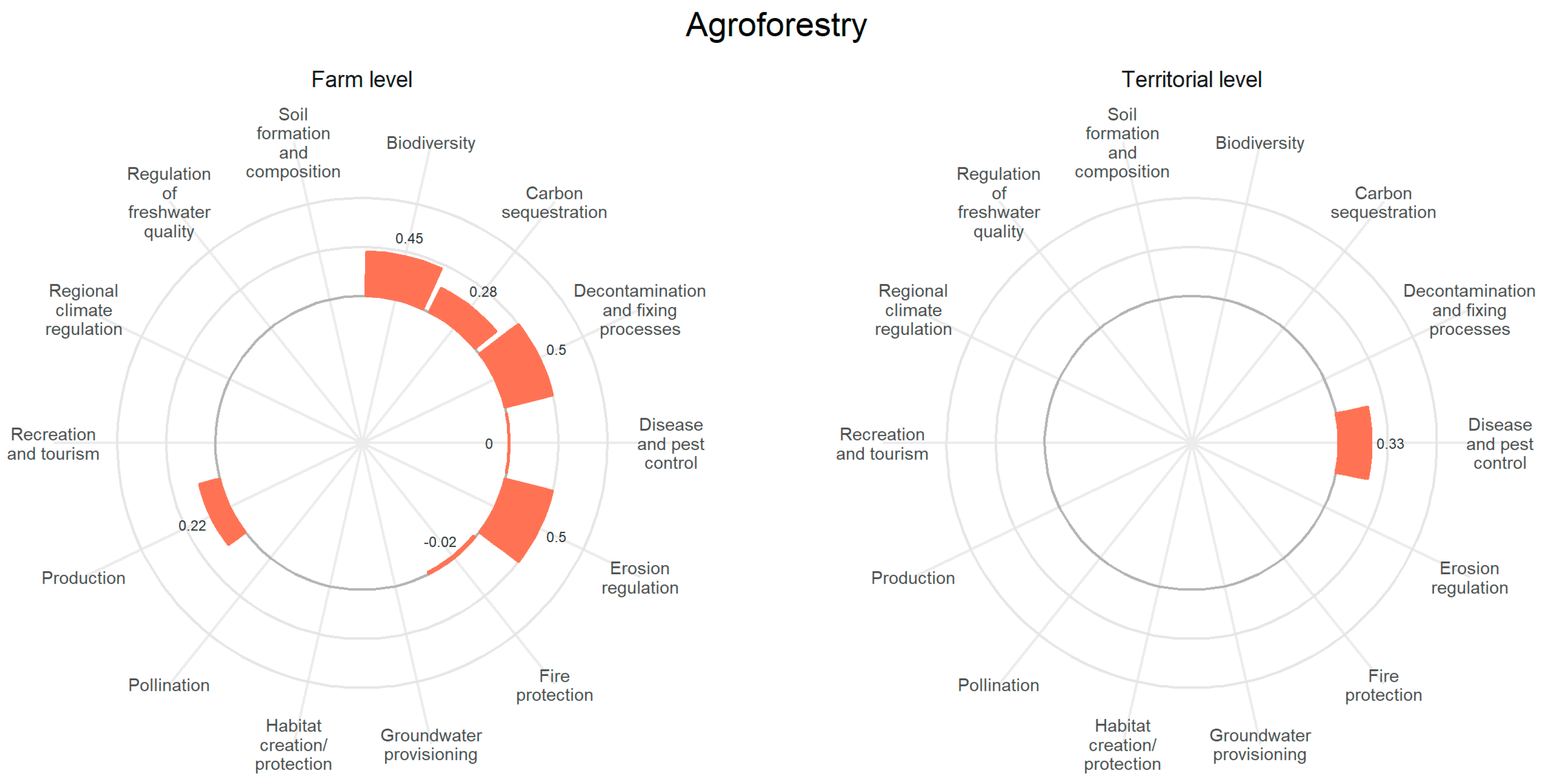
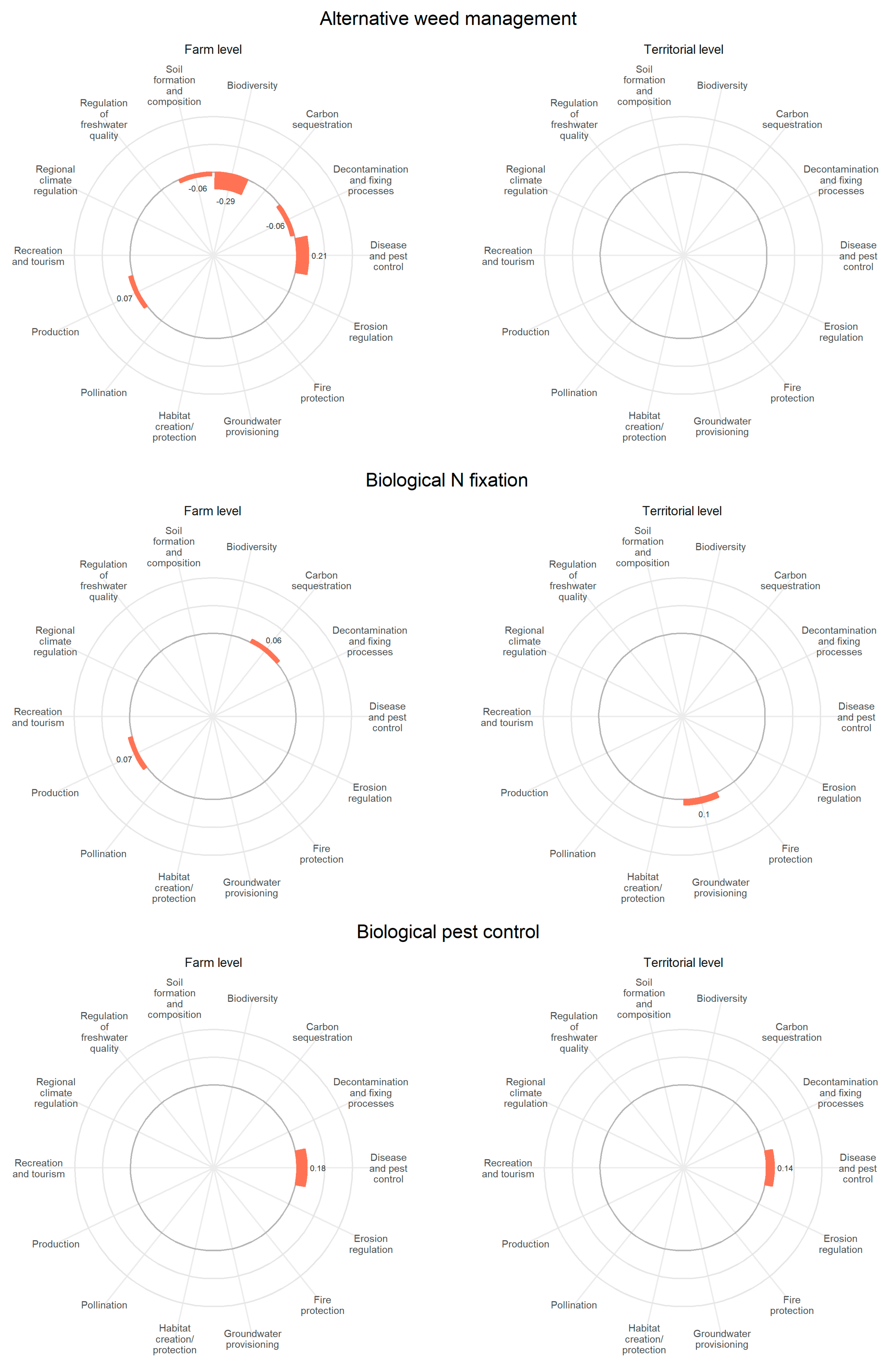
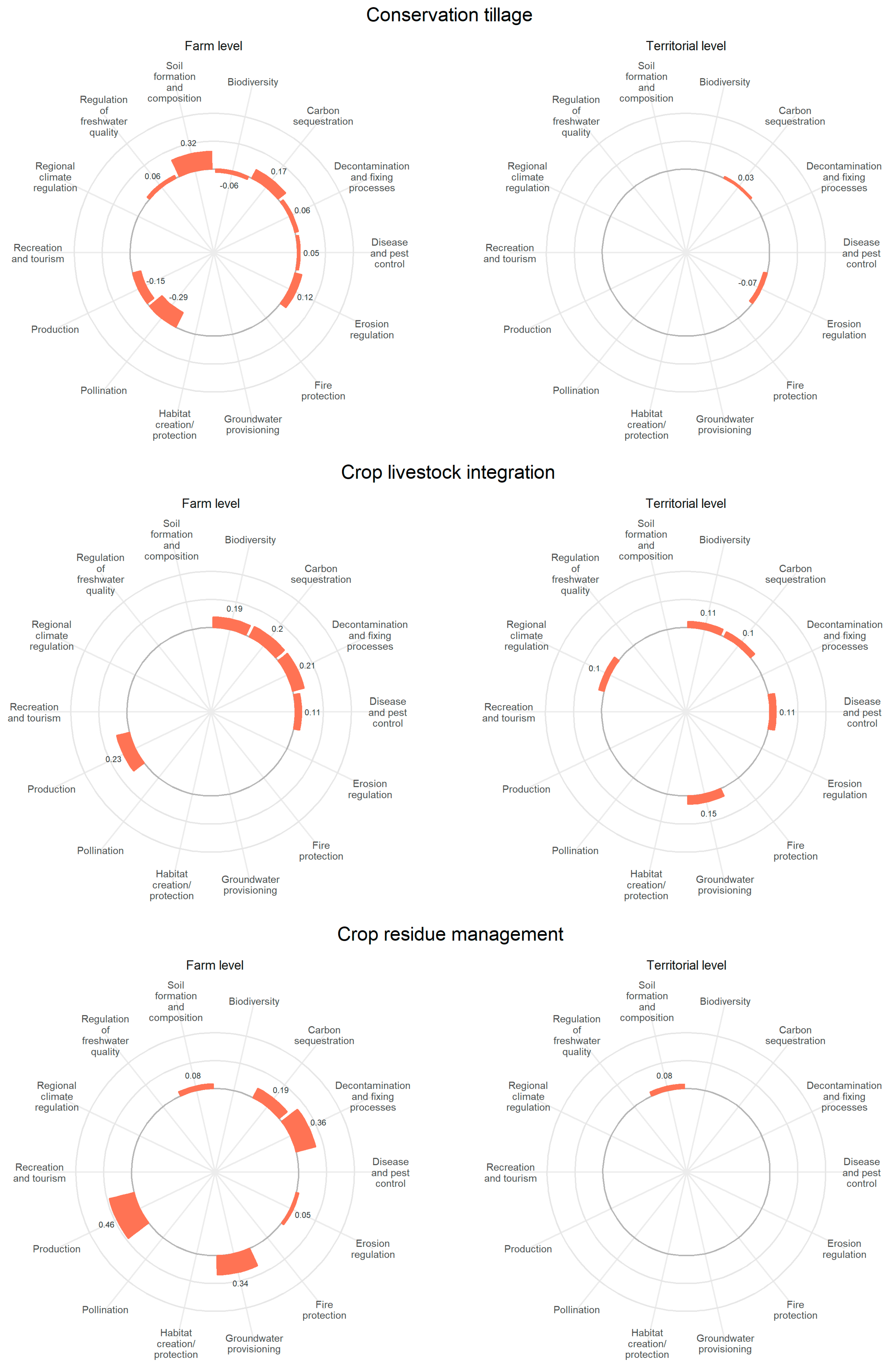
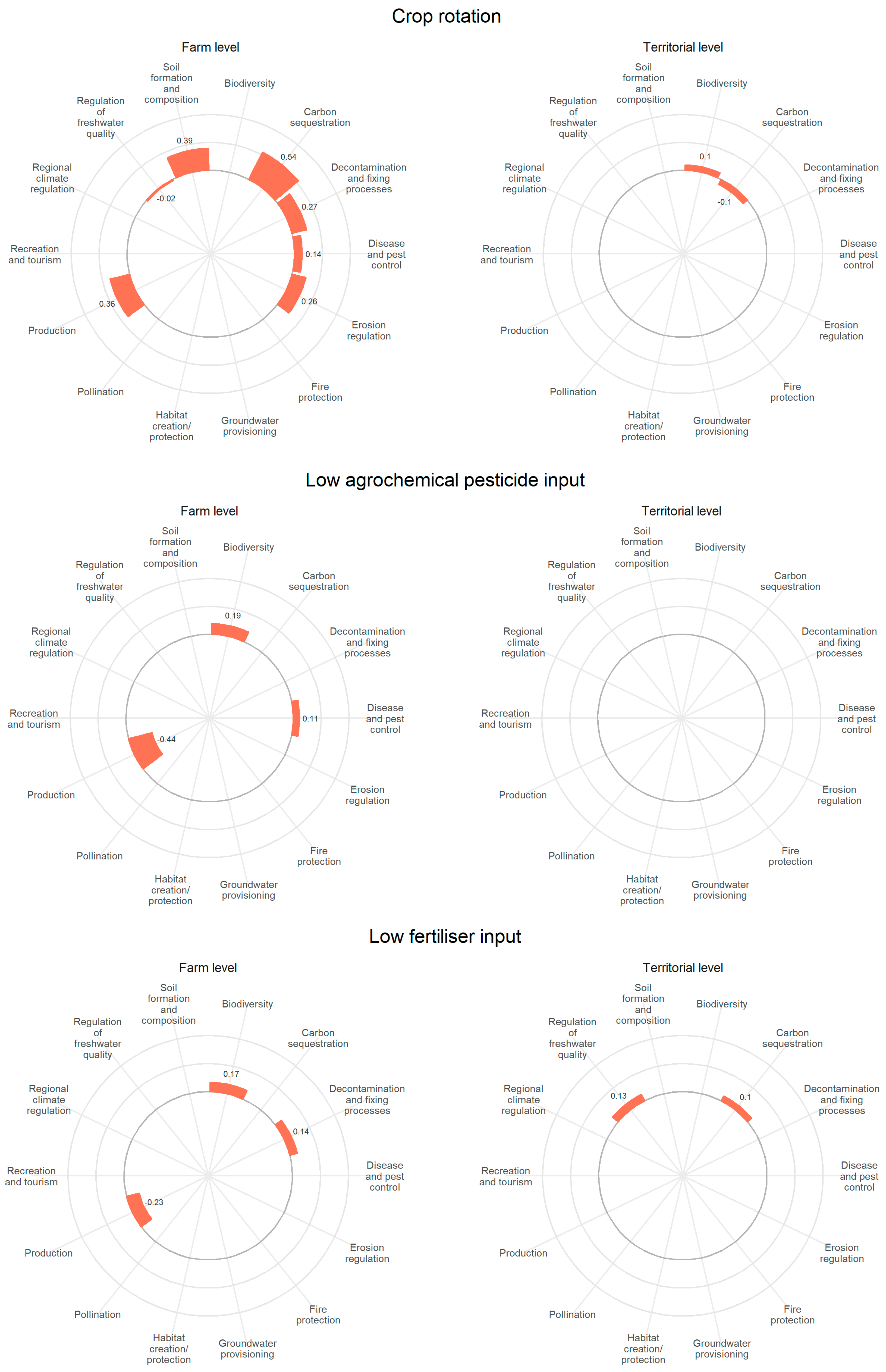
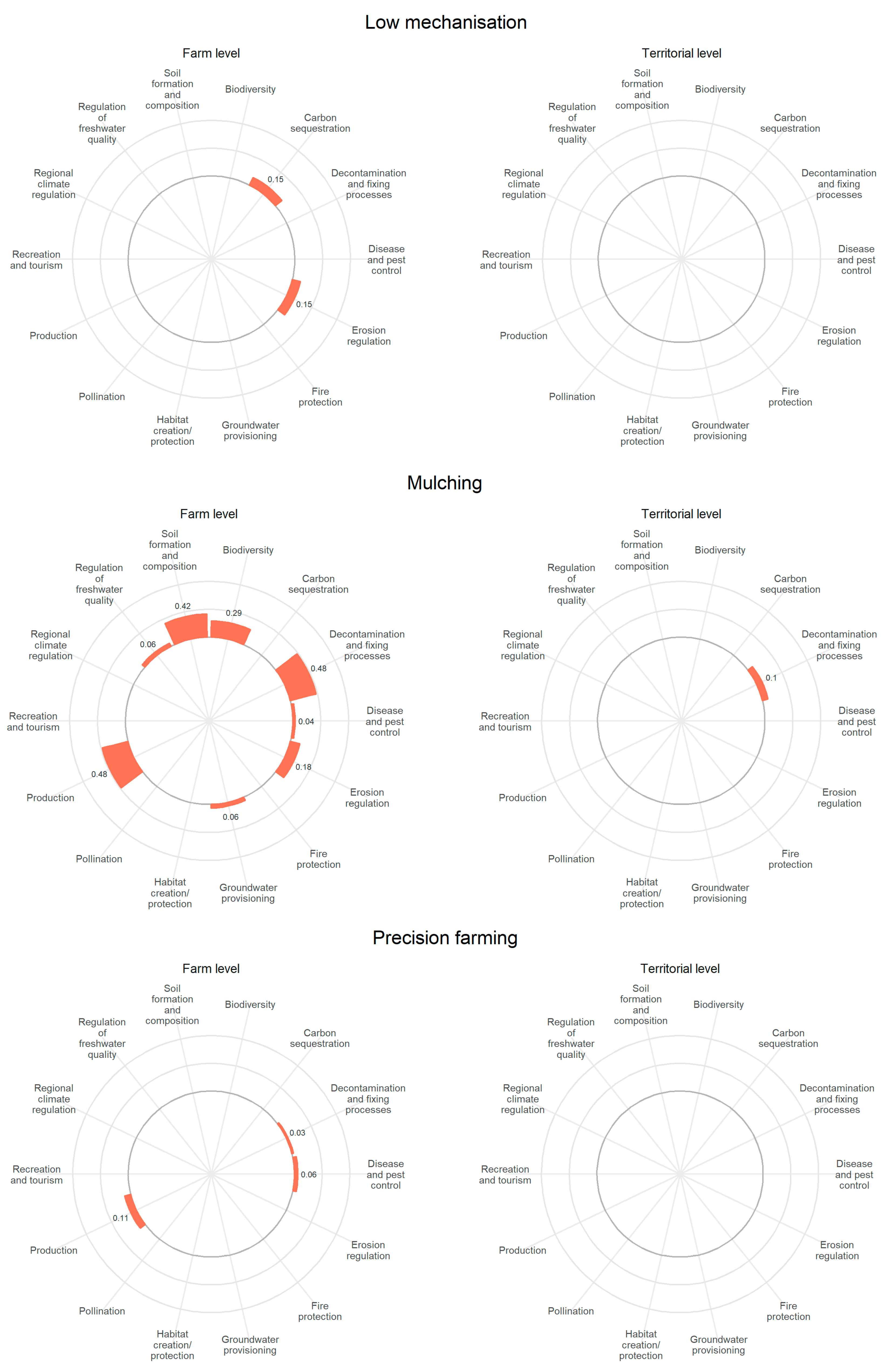
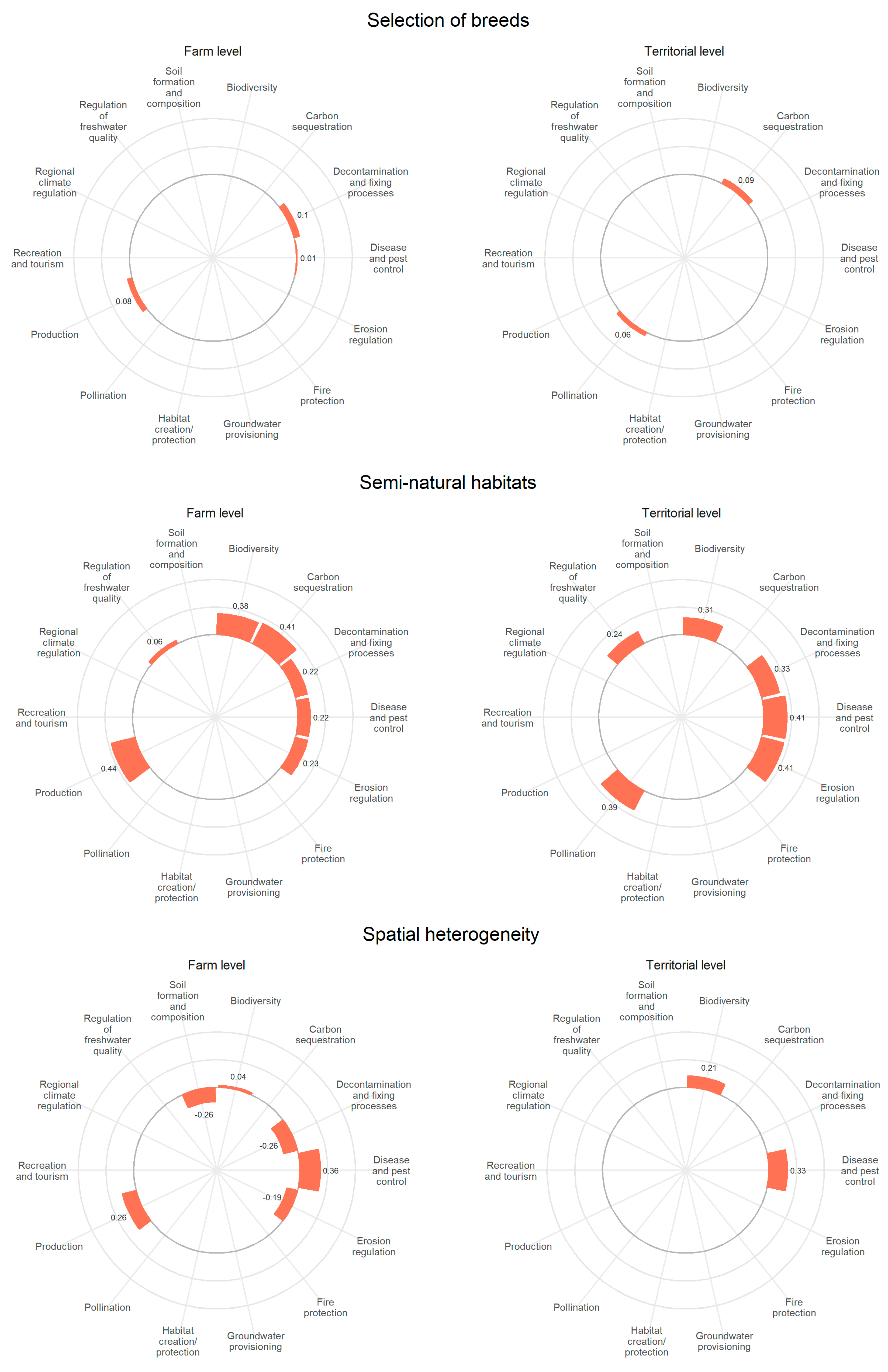
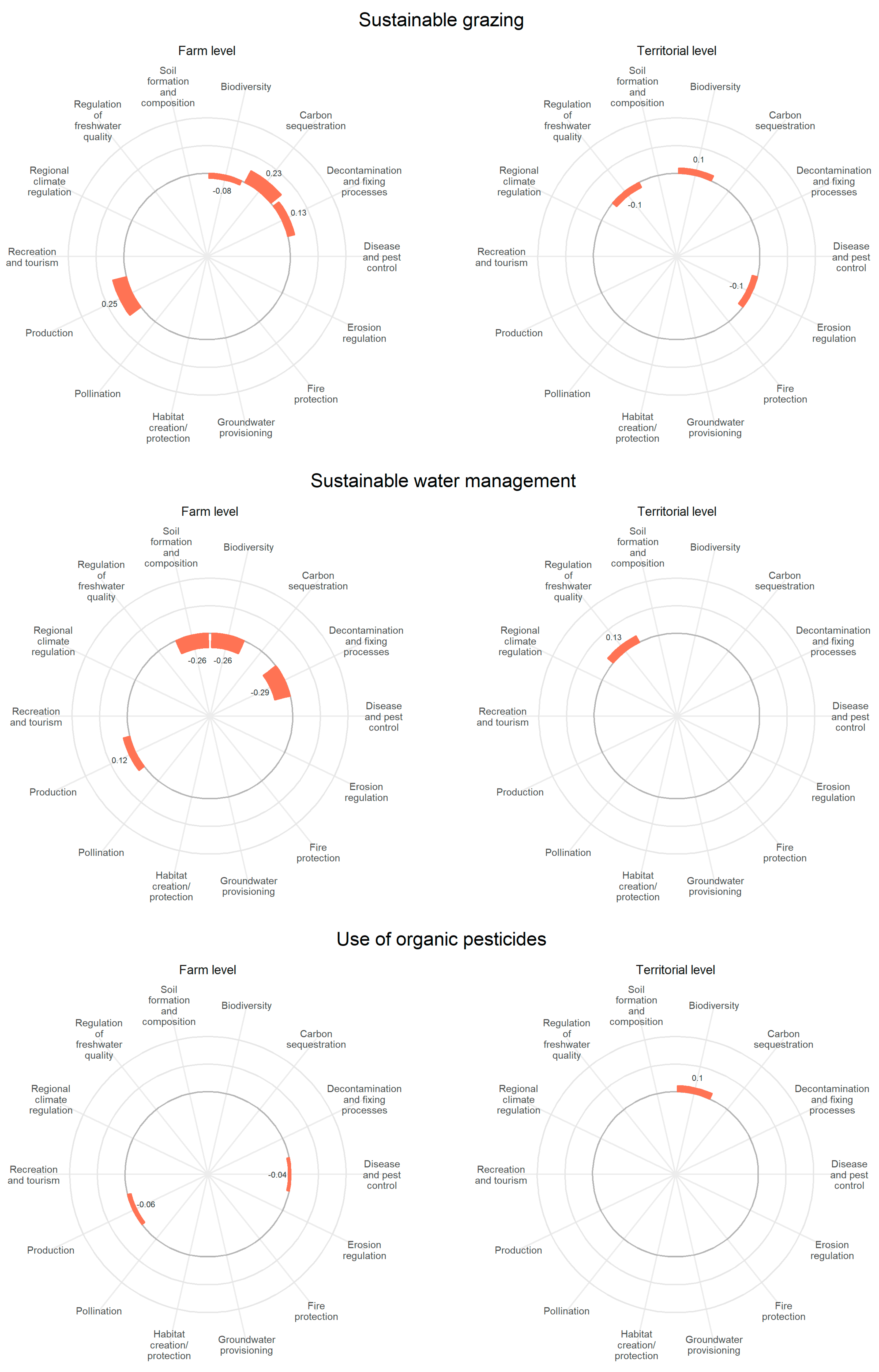
References
- CICES. Revision Highlights. 2018. Available online: https://cices.eu/revision-highlights/ (accessed on 23 December 2020).
- Van Zanten, B.T.; Verburg, P.H.; Espinosa, M.; Gomez-Y-Paloma, S.; Galimberti, G.; Kantelhardt, J.; Kapfer, M.; Lefebvre, M.; Manrique, R.; Piorr, A.; et al. European agricultural landscapes, common agricultural policy and ecosystem services: A review. Agron. Sustain. Dev. 2014, 34, 309–325. [Google Scholar] [CrossRef]
- Sandhu, H.S.; Wratten, S.D.; Cullen, R. Organic agriculture and ecosystem services. Environ. Sci. Policy 2010, 13, 1–7. [Google Scholar] [CrossRef]
- Swinton, S.M.; Lupi, F.; Robertson, G.P.; Landis, D.A. Ecosystem services from agriculture: Looking beyond the usual suspects. Am. J. Agric. Econ. 2006, 88, 1160–1166. [Google Scholar] [CrossRef]
- Swinton, S.M.; Lupi, F.; Robertson, G.P.; Hamilton, S.K. Ecosystem services and agriculture: Cultivating agricultural ecosystems for diverse benefits. Ecol. Econ. 2007, 64, 245–252. [Google Scholar] [CrossRef]
- Pretty, J.; Bharucha, Z.P. Sustainable intensification in agricultural systems. Ann. Bot. 2014, 114, 1571–1596. [Google Scholar] [CrossRef]
- Bateman, I.; Brouwer, R.; Cranford, M. Valuing Environmental Impacts: Practical Guidelines for the Use of Value Transfer in Policy and Project Appraisal. Value Transf. Guidel. 2009, 44, 1–23. [Google Scholar]
- Nicholls, C.I.; Altieri, M.A.; Vazquez, L. Agroecological Principles for the Conversion of Farming Systems. In Agroecological Practices for Sustainable Agriculture: Principles, Application, and Making the Transition; World Scientific: Singapore, 2017; pp. 1–18. [Google Scholar]
- Pretty, J. Agricultural sustainability: Concepts, principles and evidence. Philos. Trans. R. Soc. B Biol. Sci. 2008, 363, 447–465. [Google Scholar] [CrossRef]
- Maes, J.; Teller, A.; Nessi, S.; Bulgheroni, C.; Konti, A.; Sinkko, T.; Tonini, D.; Pant, R. Mapping and Assessment of Ecosystems and Their Services: An EU Ecosystem Assessment; Publications Office of the European Union: Luxembourg, 2020; ISBN 9789276178330. [Google Scholar]
- Batáry, P.; Dicks, L.V.; Kleijn, D.; Sutherland, W.J. The role of agri-environment schemes in conservation and environmental management. Conserv. Biol. 2015, 29, 1006–1016. [Google Scholar] [CrossRef]
- Bartkowski, B.; Droste, N.; Ließ, M.; Sidemo-Holm, W.; Weller, U.; Brady, M.V. Payments by modelled results: A novel design for agri-environmental schemes. Land Use Policy 2021, 102, 105230. [Google Scholar] [CrossRef]
- Tancoigne, E.; Barbier, M.; Cointet, J.P.; Richard, G. The place of agricultural sciences in the literature on ecosystem services. Ecosyst. Serv. 2014, 10, 35–48. [Google Scholar] [CrossRef]
- Van Vooren, L.; Reubens, B.; Broekx, S.; De Frenne, P.; Nelissen, V.; Pardon, P.; Verheyen, K. Ecosystem service delivery of agri-environment measures: A synthesis for hedgerows and grass strips on arable land. Agric. Ecosyst. Environ. 2017, 244, 32–51. [Google Scholar] [CrossRef]
- Toivonen, M.; Huusela-Veistola, E.; Herzon, I. Perennial fallow strips support biological pest control in spring cereal in Northern Europe. Biol. Control 2018, 121, 109–118. [Google Scholar] [CrossRef]
- Van den Putte, A.; Govers, G.; Diels, J.; Gillijns, K.; Demuzere, M. Assessing the effect of soil tillage on crop growth: A meta-regression analysis on European crop yields under conservation agriculture. Eur. J. Agron. 2010, 33, 231–241. [Google Scholar] [CrossRef]
- Collins, A.; Miller, J.; Coughlin, D.; Kirk, S. The Production of Quick Scoping Reviews and Rapid Evidence Assessments: A How to Guide; 2015. Available online: https://www.gov.uk/government/publications/the-production-of-quick-scoping-reviews-and-rapid-evidence-assessments (accessed on 9 December 2019).
- Rigby, D.; Woodhouse, P.; Young, T.; Burton, M. Constructing a farm level indicator of sustainable agricultural practice. Ecol. Econ. 2001, 39, 463–478. [Google Scholar] [CrossRef]
- Cochrane. About Cochrane Reviews|Cochrane Library; John Wiley & Sons, Inc.: Hoboken, NJ, USA, 2022; Available online: https://www.cochranelibrary.com/about/about-cochrane-reviews (accessed on 24 February 2022).
- Rega, C.; Paracchini, M.L.; Mccraken, D.; Saba, A.; Zavalloni, M.; Raggi, M.; Viaggi, D.; Britz, W.; Frappier, L. LIFT-Deliverable D1.1 Review of the definitions of the existing ecological approaches. In LIFT—Low-Input Farming and Territories—Integrating Knowledge for Improving Ecosystem Based Farming; 2018; Available online: https://www.lift-h2020.eu/deliverables/ (accessed on 26 August 2022).
- Varker, T.; Forbes, D.; Dell, L.; Weston, A.; Merlin, T.; Hodson, S.; O’Donnell, M. Rapid evidence assessment: Increasing the transparency of an emerging methodology. J. Eval. Clin. Pract. 2015, 21, 1199–1204. [Google Scholar] [CrossRef]
- Collaboration for Environmental Evidence. Guidelines for Systematic Review and Evidence Synthesis in Environmental Management; Collaboration for Environmental Evidence: New York, NY, USA, 2013. [Google Scholar]
- Clarivate. Web of Science Core Collection. 2021. Available online: https://www.webofscience.com/wos/woscc/basic-search (accessed on 12 July 2021).
- Ottoy, S.; Angileri, V.; Gibert, C.; Paracchini, M.L.; Pointereau, P.; Terres, J.M.; Van Orshoven, J.; Vranken, L.; Dicks, L.V. Impacts of selected Ecological Focus Area options in European farmed landscapes on climate regulation and pollination services: A systematic map protocol. Environ. Evid. 2018, 7, 10. [Google Scholar] [CrossRef]
- Beillouin, D.; Ben-Ari, T.; Makowski, D. A dataset of meta-analyses on crop diversification at the global scale. Data Brief 2019, 24, 103898. [Google Scholar] [CrossRef]
- PRISMA. PRISMA: Transparent Reporting of Systematic Reviews and Meta-Analyses. 2015. Available online: http://www.prisma-statement.org/ (accessed on 3 March 2021).
- Beillouin, D.; Ben-ari, T.; Makoswki, D. Assessing the Quality and Results of Meta-Analyses on Crop Diversification Protocol for Systematic Review and Evidence Map; hal-01815485; HAL: Tokyo, Japan, 2018. [Google Scholar]
- Philibert, A.; Loyce, C.; Makowski, D. Assessment of the quality of meta-analysis in agronomy. Agric. Ecosyst. Environ. 2012, 148, 72–82. [Google Scholar] [CrossRef]
- Tastle, W.J.; Wierman, M.J. Consensus and dissention: A measure of ordinal dispersion. Int. J. Approx. Reason. 2007, 45, 531–545. [Google Scholar] [CrossRef]
- Winter, S.; Bauer, T.; Strauss, P.; Kratschmer, S.; Paredes, D.; Popescu, D.; Landa, B.; Guzmán, G.; Gómez, J.A.; Guernion, M.; et al. Effects of vegetation management intensity on biodiversity and ecosystem services in vineyards: A meta-analysis. J. Appl. Ecol. 2018, 55, 2484–2495. [Google Scholar] [CrossRef]
- Kuppusamy, S.; Kakarla, D.; Venkateswarlu, K.; Megharaj, M.; Yoon, Y.E.; Lee, Y.B. Veterinary antibiotics (VAs) contamination as a global agro-ecological issue: A critical view. Agric. Ecosyst. Environ. 2018, 257, 47–59. [Google Scholar] [CrossRef]
- Öllerer, K.; Varga, A.; Kirby, K.; Demeter, L.; Biró, M.; Bölöni, J.; Molnár, Z. Beyond the obvious impact of domestic livestock grazing on temperate forest vegetation—A global review. Biol. Conserv. 2019, 237, 209–219. [Google Scholar] [CrossRef]
- Zhang, W.; Ricketts, T.H.; Kremen, C.; Carney, K.; Swinton, S.M. Ecosystem services and dis-services to agriculture. Ecol. Econ. 2007, 64, 253–260. [Google Scholar] [CrossRef]
- Robertson, G.P.; Gross, K.L.; Hamilton, S.K.; Landis, D.A.; Schmidt, T.M.; Snapp, S.S.; Swinton, S.M. Farming for ecosystem services: An ecological approach to production agriculture. Bioscience 2014, 64, 404–415. [Google Scholar] [CrossRef] [PubMed]
- Boerema, A.; Rebelo, A.J.; Bodi, M.B.; Esler, K.J.; Meire, P. Are ecosystem services adequately quantified? J. Appl. Ecol. 2017, 54, 358–370. [Google Scholar] [CrossRef]
- Lastra-Bravo, X.B.; Hubbard, C.; Garrod, G.; Tolón-Becerra, A. What drives farmers’ participation in EU agri-environmental schemes?: Results from a qualitative meta-analysis. Environ. Sci. Policy 2015, 54, 1–9. [Google Scholar] [CrossRef]
- Villanueva, A.J.; Gómez-Limón, J.A.; Arriaza, M.; Rodríguez-Entrena, M. The design of agri-environmental schemes: Farmers’ preferences in southern Spain. Land Use Policy 2015, 46, 142–154. [Google Scholar] [CrossRef]
- Prager, K. Agri-environmental collaboratives for landscape management in Europe. Curr. Opin. Environ. Sustain. 2015, 12, 59–66. [Google Scholar] [CrossRef]
- Cooper, H.; Hedges, L.V.; Valentine, J.C. The Handbook of Research Synthesis and Meta-Analysis, 2nd ed.; Russell Sage Foundation: New York, NY, USA, 2009. [Google Scholar]
- McKenzie, J.; Brennan, S. Chapter 12: Synthesizing and presenting findings using other methods. In Cochrane Handbook for Systematic Reviews of Interventions Version 6.3; Higgins, J.P.T., Thomas, J., Chandler, J., Cumpston, M., Li, T., Page, M.J., Eds.; Updated February 2022; Cochrane: London, UK, 2022. [Google Scholar]
- Ouzzani, M.; Hammady, H.; Fedorowicz, Z.; Elmagarmid, A. Rayyan-a web and mobile app for systematic reviews. Syst. Rev. 2016, 5, 210. [Google Scholar] [CrossRef]
- Rayyan. Rayyan—Intelligent Systematic Review [WWW Document]. 2021. Available online: https://www.rayyan.ai/ (accessed on 7 December 2021).
Disclaimer/Publisher’s Note: The statements, opinions, and data contained in all publications are solely those of the individual author(s) and contributor(s) and not of MDPI and/or the editor(s). MDPI and/or the editor(s) disclaim responsibility for any injury to people or property resulting from any ideas, methods, instructions, or products referred to in the content. |
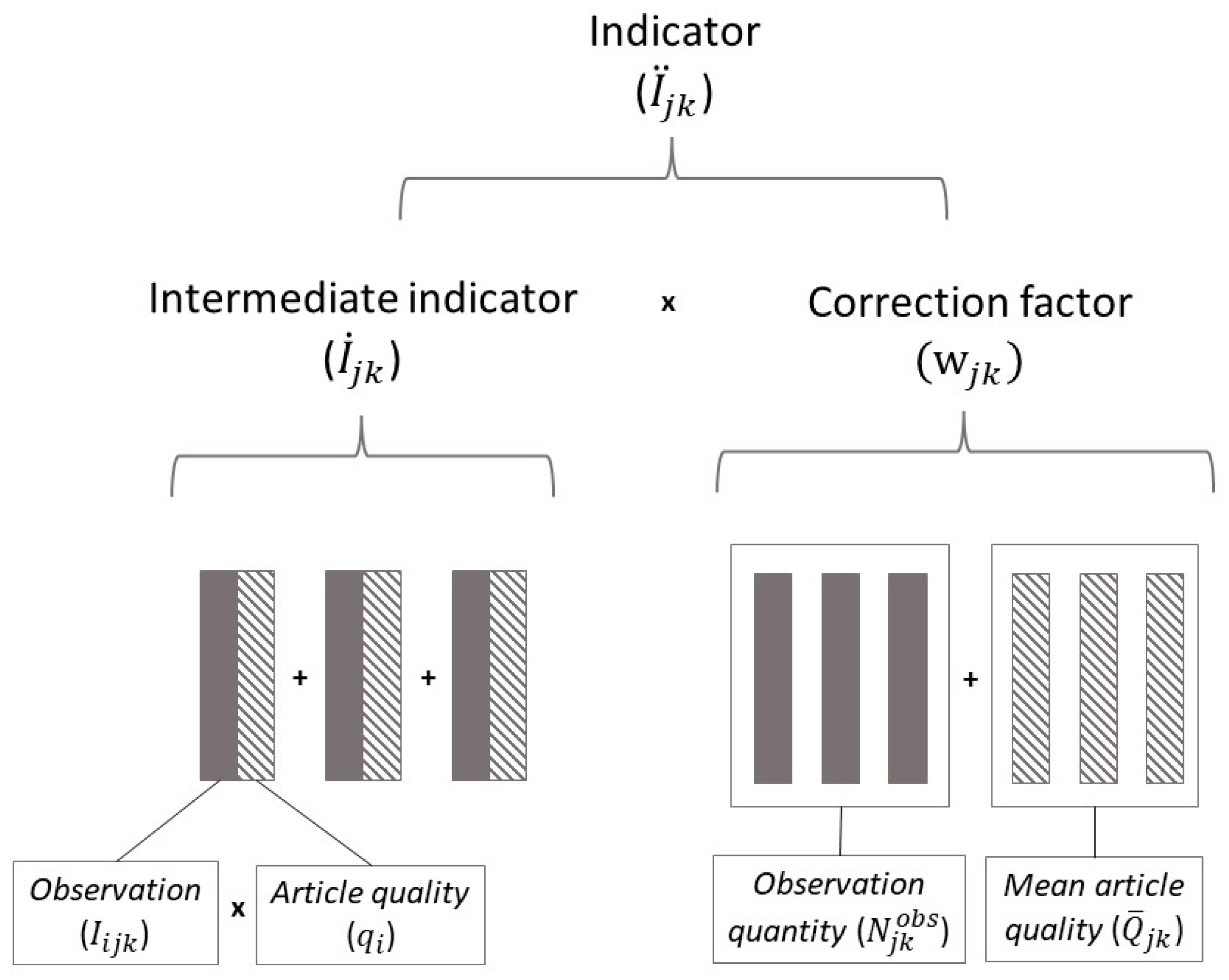
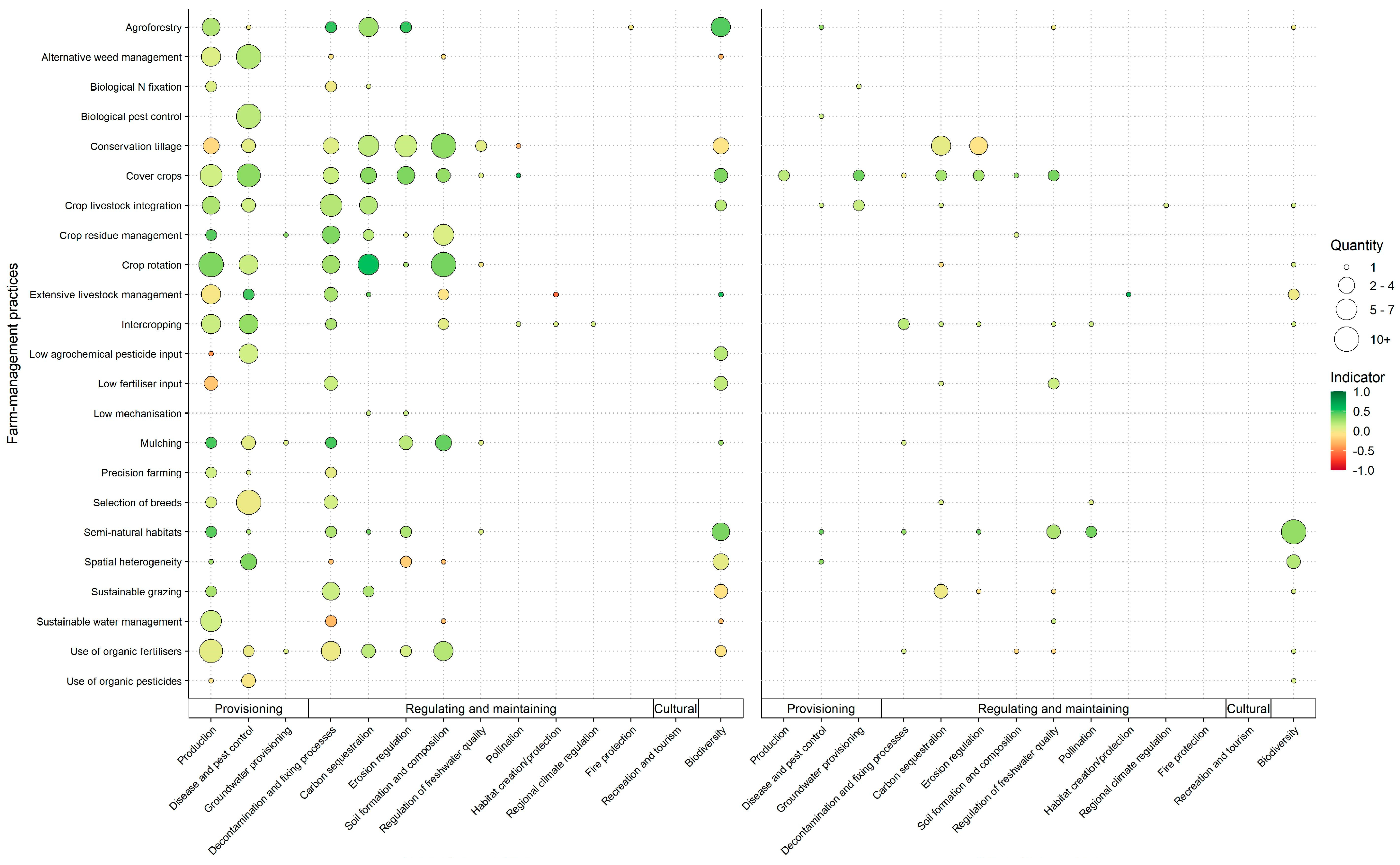


| PICO | Component | Objective |
|---|---|---|
| Population | Quantitative or qualitative secondary literature | Robustly inform performance indicators using pre-existing literature reviews, quick scoping reviews, rapid evidence assessments, meta-analyses, systematic reviews, and reviews of reviews; quantitative and qualitative data were extracted to inform results. |
| Population | European agricultural land | Use the most locally relevant data on practices and their effects. |
| Intervention/exposure | Farm-management practices | Cover the variety of practices to be included in the assessment. |
| Comparator | Conventional, intensive management practices | Compare conventional approaches to agriculture with more ecological approaches. The comparator is assumed to be embedded in the secondary literature. |
| Outcome | Ecosystem services | Measure, through the use of indicators, proxies, or qualitative data, the impact of adoption of farm-management practices on ES supply. |
Disclaimer/Publisher’s Note: The statements, opinions and data contained in all publications are solely those of the individual author(s) and contributor(s) and not of MDPI and/or the editor(s). MDPI and/or the editor(s) disclaim responsibility for any injury to people or property resulting from any ideas, methods, instructions or products referred to in the content. |
© 2023 by the authors. Licensee MDPI, Basel, Switzerland. This article is an open access article distributed under the terms and conditions of the Creative Commons Attribution (CC BY) license (https://creativecommons.org/licenses/by/4.0/).
Share and Cite
Van Ruymbeke, K.; Ferreira, J.G.; Gkisakis, V.D.; Kantelhardt, J.; Manevska-Tasevska, G.; Matthews, P.; Niedermayr, A.; Schaller, L.; Bańkowska, K.; Mertens, K.; et al. Assessing the Impact of Farm-Management Practices on Ecosystem Services in European Agricultural Systems: A Rapid Evidence Assessment. Sustainability 2023, 15, 12819. https://doi.org/10.3390/su151712819
Van Ruymbeke K, Ferreira JG, Gkisakis VD, Kantelhardt J, Manevska-Tasevska G, Matthews P, Niedermayr A, Schaller L, Bańkowska K, Mertens K, et al. Assessing the Impact of Farm-Management Practices on Ecosystem Services in European Agricultural Systems: A Rapid Evidence Assessment. Sustainability. 2023; 15(17):12819. https://doi.org/10.3390/su151712819
Chicago/Turabian StyleVan Ruymbeke, Kato, Joana G. Ferreira, Vasileios D. Gkisakis, Jochen Kantelhardt, Gordana Manevska-Tasevska, Peter Matthews, Andreas Niedermayr, Lena Schaller, Katarzyna Bańkowska, Kewan Mertens, and et al. 2023. "Assessing the Impact of Farm-Management Practices on Ecosystem Services in European Agricultural Systems: A Rapid Evidence Assessment" Sustainability 15, no. 17: 12819. https://doi.org/10.3390/su151712819
APA StyleVan Ruymbeke, K., Ferreira, J. G., Gkisakis, V. D., Kantelhardt, J., Manevska-Tasevska, G., Matthews, P., Niedermayr, A., Schaller, L., Bańkowska, K., Mertens, K., & Vranken, L. (2023). Assessing the Impact of Farm-Management Practices on Ecosystem Services in European Agricultural Systems: A Rapid Evidence Assessment. Sustainability, 15(17), 12819. https://doi.org/10.3390/su151712819






